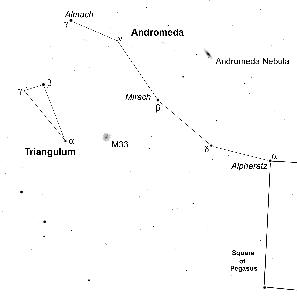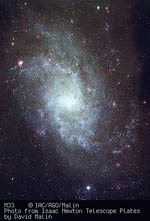Andromeda and Triangulum
These two constellations, adjacent in the sky, contain two A-List objects: the galaxies M31 and M33. These are the other two galaxies that with our own galaxy, the Milky Way, are the three major galaxies in our Local Group of galaxies. The distribution of galaxies in the Local Group is a little like a dumbell with the Milky Way galaxy at the centre of one weight with M31 and M33 at the heart of the other weight some 2.5 to 3.0 million Light years distance from us. This is why they appear relatively close in the sky. These galaxies are best seen during the months before Christmas, high overhead for northern observers, but low in the north for southern.
M31 The Andromeda Galaxy Spiral Galaxy E B L
M31 is the nearest large galaxy to us lying at a distance of 2.9 million light years. It is the largest galaxy in our Local Group and is a spiral galaxy of type Sb somewhat larger than our own Milky Way. With a magnitude of 3.4 it is visible to the unaided eye - the most distant object in the Universe that most can see using just their eyes! The easiest way to locate it is to star hop from the star Sirra, Alpha Andromedae, which also forms the north western star of the square of Pegasus. Move first two stars westwards and a little north to the star Mirach then turn 90 degrees clockwise and move to the first bright star. Then, moving in the same direction by the same amount, you should easily pick up a fuzzy white glow which is the nucleus of M31. If Pegasus is low, then a second way of finding it is to follow the "arrow" made by the eastmost three stars of Cassiopea. Andromeda is 15 degrees (about three binocular fields of view) from the tip of the arrow.
You can see the heart of M31 with your unaided eye as a fuzzy white patch of light, but is is best seen with binoculars under dark and transparent skies. Then, with well dark adapted eyes, is is possible to get some feeling of the extent of the galaxy which stretches some 3 x1 degrees in angular size - spanning half way across a typical binocular field. Using a telescope with low power is also rewarding as, if one slowly sweeps the field of view across the glalaxy, it is possible to pick out some of the dark dust lanes that cut across the faint starlight.
M31 has two daughter galaxies M32 and M110. Both are elliptical and seen as tight fuzzy balls. M32 , magnitude 8.4, appears closer to the centre of M31 and is a type E2 galaxy - almost spherical. M110, of type E6 and magnitude 8.5, is more obviously elongated.
position: 0h 42.7m +41deg 16min
M33 - The Triangulum Galaxy B L
M33 is a face-on type Sc spiral galaxy which lies at a distance of 3 million light years and is the third largest galaxy in our Local Group. With a magnitude of 5.7 those with very acute eyes under perfect conditions might just be able to observe it with the unaided eye but, as it is face-on to us, the light is well spread out and most will only ever observe it with binoculars or a telescope - even with such optical aids very dark and transparent skies are needed. From M31, retrace your step to the star Mirach and continue on in the same direction for about the same distance - seven degrees, between one and two binocular fields. In binoculars it appears like a little piece of tissue paper stuck on the sky - just a little brighter that the surroundings. Larger telecopes - say 8 inches (200mm) aperture or larger may just show a hint of the open spiral arms surrounding the compact nucleus. Though, with an overall diameter of ~ 60,000 light years it is much smaller than M31 or our own Milky Way, it is more typical of spiral galaxies across the Universe.
position: 1h 33.9m +30deg 39min






